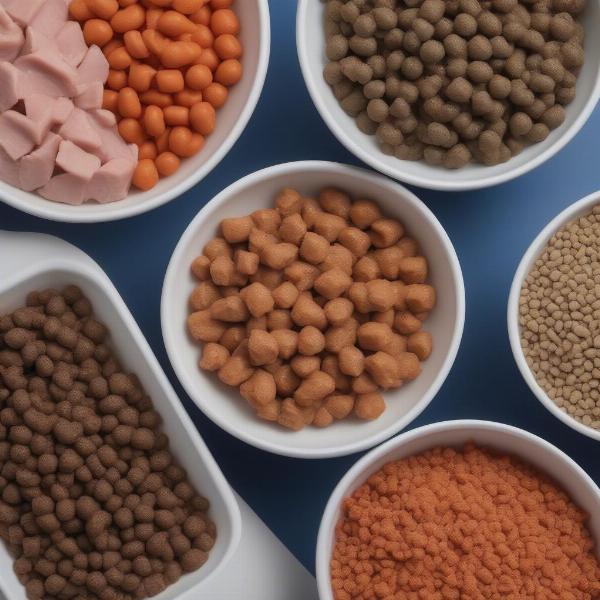Finding the right wet dog food can be tricky, especially if your furry friend has dietary restrictions. Many dogs are allergic or intolerant to chicken, a common ingredient in commercial pet food. This guide explores the world of wet dog food without chicken, offering insights into alternative protein sources, nutritional considerations, and how to choose the best option for your canine companion.
Why Choose Chicken-Free Wet Dog Food?
Chicken allergies are a prevalent issue in dogs, manifesting in symptoms ranging from itchy skin and digestive upset to more severe reactions. Opting for chicken-free wet food eliminates the source of the allergy, alleviating these symptoms and improving your dog’s overall well-being. Furthermore, some pet owners prefer to diversify their dog’s protein intake for optimal nutrition.
Exploring Alternative Protein Sources
Thankfully, numerous delicious and nutritious alternatives to chicken exist in wet dog food. These include:
- Fish: Salmon, tuna, and whitefish are excellent sources of omega-3 fatty acids, promoting healthy skin and coat. whitefish dog food provides a hypoallergenic option for sensitive dogs.
- Beef: A palatable and readily available protein, beef provides essential amino acids for muscle development.
- Lamb: Often recommended for dogs with sensitive stomachs, lamb is a highly digestible protein source.
- Turkey: A lean protein option, turkey is lower in fat than beef and can be a good choice for dogs watching their weight.
- Venison: A novel protein source, venison is less likely to trigger allergies in dogs with sensitivities.
 Bowls of wet dog food with different protein sources
Bowls of wet dog food with different protein sources
Nutritional Considerations for Chicken-Free Wet Food
When choosing chicken-free wet food, look for a complete and balanced formula that meets your dog’s specific life stage and health needs. Consider the following:
- Life Stage: Puppies, adults, and senior dogs require different nutrient profiles. Puppy food is higher in calories and protein to support growth, while senior formulas often contain joint support supplements.
- Health Conditions: Dogs with allergies, sensitivities, or specific health conditions may benefit from specialized formulas. For instance, a dog with kidney disease might require a low-phosphorus diet.
- Ingredients: Check the ingredient list for high-quality protein sources, wholesome grains or grain-free options, and avoid artificial flavors, colors, and preservatives.
Making the Switch to Chicken-Free Wet Food
Transitioning to a new food should be gradual to prevent digestive upset. Start by mixing a small amount of the new food with your dog’s current food, gradually increasing the proportion of new food over several days until the transition is complete.
What if My Dog Still Has Allergies?
If your dog continues to experience allergy symptoms even on a chicken-free diet, consult your veterinarian. They can perform allergy testing to identify the specific allergen and recommend the most appropriate dietary changes. ez complete for dogs can be a helpful resource in understanding complete and balanced nutrition for dogs.
Conclusion
Choosing wet dog food without chicken provides a solution for dogs with chicken allergies or intolerances and allows for dietary diversification. By understanding the available protein alternatives and nutritional considerations, you can select the best option to keep your canine companion happy, healthy, and allergy-free. Remember to consult with your vet for personalized advice tailored to your dog’s specific needs. by nature dog food is another great option to explore for natural and wholesome dog food choices.
FAQ
-
What are the most common signs of a chicken allergy in dogs? Itching, redness, digestive upset, ear infections, and hair loss are common signs.
-
Are grain-free wet dog foods better for dogs with chicken allergies? Not necessarily. While some dogs benefit from grain-free diets, the allergy is to chicken, not grains. Focus on eliminating chicken and choosing a high-quality protein source.
-
Can I make homemade chicken-free wet dog food? While possible, it’s crucial to ensure the recipe is nutritionally complete and balanced. Consult a veterinary nutritionist for guidance.
-
How long does it take to see improvement in allergy symptoms after switching to a chicken-free diet? It can take several weeks to see noticeable improvement.
-
What should I do if my dog doesn’t like the new chicken-free wet food? Try different brands and protein sources. Mixing the new food with a small amount of something your dog enjoys can also help.
ILM Dog is a leading international online resource dedicated to providing dog owners with expert advice and information on all aspects of canine care, including breed selection, health, training, nutrition, grooming, and much more. We are committed to helping you make informed decisions about your dog’s well-being. For expert guidance and personalized recommendations on choosing the right wet dog food without chicken for your furry friend, contact us at [email protected] or call us at +44 20-3965-8624. ILM Dog is here to support you every step of the way.